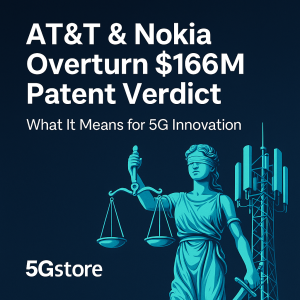
Table of Contents
Introduction
On September 24, 2025, a U.S. appeals court handed a notable win to AT&T and Nokia by overturning a $166 million verdict in a patent infringement case. For companies operating in the telecommunications and wireless infrastructure sector (like ours at 5Gstore), this ruling carries important implications — especially around risk, licensing, and confidence in deploying advanced 5G technologies.
In this post, we break down the case, analyze what changed, and explore what it means for the 5G supply and adoption landscape.
The Case: Finesse Wireless vs. AT&T & Nokia — The Essentials
Who sued whom?
- In 2021, Finesse Wireless, a patent-holding company based in Utah, filed a lawsuit against AT&T, alleging that its 4G and 5G wireless networks infringed on patents related to reducing signal interference.
- Nokia intervened, arguing that its equipment used by AT&T did not infringe and defending the design and implementation of its base stations.
What happened earlier?
- A Texas jury in 2023 ruled in Finesse’s favor and awarded more than $166 million in damages.
- AT&T and Nokia appealed to the U.S. Court of Appeals for the Federal Circuit.
What did the appeals court decide?
- The appeals court reversed the jury verdict.
- The court found that the original decision lacked sufficient evidence to support the infringement findings.
- AT&T’s use of Nokia’s network equipment was declared non-infringing under the relevant patents held by Finesse.
In the view of Nokia, the appeals court came to the right conclusion.
Why This Ruling Matters for the 5G Ecosystem
While patent litigation often sounds distant for network operators or component suppliers, this decision has several ramifications that matter:
1. Less Legal Risk for Deployment
One of the biggest costs in deploying advanced wireless infrastructure is the risk of downstream patent claims. A ruling that supports non-infringement (or at least demands higher proof of infringement) helps reduce that risk. Suppliers, carriers, and even smaller innovators can have more confidence in investing in new 5G capabilities.
2. Strengthening the Role of Evidence and Validity
By emphasizing that the jury lacked sufficient evidence, the appeals court underscores the importance of robust, technically grounded arguments — not just legal strategy. In future patent disputes, courts may demand more rigorous proof of infringement, which can act as a deterrent against overly aggressive patent assertion.
3. Impact on Royalty Demands and Licensing Strategy
Patent-holding or non-practicing entities often demand payments based on broad claims. This ruling may push down the leverage of such claims, particularly in complex technologies like 5G, where multiple layers of innovation overlap. For legitimate licensors, the bar for asserting claims may be higher — which means stronger negotiating positions but also greater scrutiny of patent portfolios.
4. Signal for Innovation Confidence
When major players like AT&T and Nokia successfully challenge large damages awards and win, that sends a positive signal to the wider industry — especially for newer entrants, systems integrators, or equipment vendors. It suggests that the legal environment (at least in the U.S.) is not stacked against those pushing technology boundaries. That confidence may accelerate deployment and R&D investment in 5G (and soon 6G) technologies.
What This Means for 5Gstore and Our Customers
At 5Gstore, we’re part of this broader ecosystem. Here are some takeaways and how we see it affecting our work and offerings:
- Lower exposure to patent litigation — For network builders, operators, or enthusiasts using or reselling 5G infrastructure gear, this ruling helps reduce a potentially hidden risk.
- More room for experimentation — With legal pressures alleviated (to some extent), vendors and integrators may be more willing to try cutting-edge deployments — such as new radio designs, edge computing modules, or untested architectures.
- Stronger emphasis on interoperability & standards compliance — Litigation risk pushes vendors to rely more on industry standards (like 3GPP) and avoid proprietary tweaks that could invite patent claims. We might see more of this in the product lineup.
- Better clarity in contracts — As patent enforcement becomes more exacting, we anticipate that licensing agreements, warranties, and indemnification clauses in supply contracts will become more precise. We — and our customers — will need to pay attention to these.
Challenges & Limitations of the Ruling
This decision doesn’t mean that all patent claims are off the table. Several caveats are worth noting:
- Not a blanket immunity — The ruling covers the specific patents and the specific implementations at issue. It doesn’t preclude future claims, especially if new or different technology is involved.
- Regional differences — U.S. courts made this decision, but patents and legal regimes differ elsewhere. What’s safe in the U.S. may not be safe abroad.
- Appeals & further litigation — Legal processes often continue — through rehearings, Supreme Court review, or new trials.
- Patent portfolios differ — Some technology areas (like core network design, chip development, or software algorithms) might carry stronger or more defensible patents than interference-related claims. Each case is unique.
Final Thoughts & Outlook Ahead
The reversal of a $166 million verdict in the Finesse v. AT&T case is a meaningful win for network operators and infrastructure providers — especially in the 5G domain. It reduces some legal uncertainty, strengthens demand for rigorous technical proof in patent disputes, and may shift the balance in licensing negotiations.
For the 5G ecosystem — vendors, integrators, operators, and service providers — this is a favorable development. It encourages continued investment in innovation without constant fear of exorbitant royalty claims.
At 5Gstore, we’ll be watching subsequent rulings and contract developments closely. Our commitment remains: deliver high-quality, standards-aligned 5G infrastructure solutions — with clarity, compliance, and minimal legal risk.

